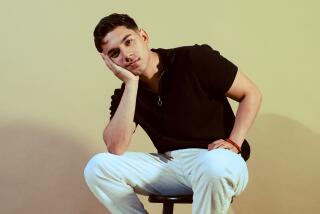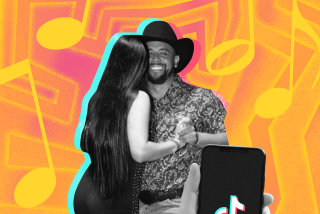Tango: pursuing a passion
The woman closes her eyes and surrenders to the music. Softly, she places her cheek against the face of her dancing partner, a spotlessly dressed middle-aged man who transports her around the room with remarkable delicacy and precision.
The woman is not what you would call a conventional beauty. But right now, gliding on the dance floor to the bittersweet strains of the bandoneon, lifting her leg to accompany an unexpected accent in the music, she is captivating.
She is completely immersed in the dance, intensely focused. At the moment there is nothing but tango on her mind. Like the dozens of people around her on this Saturday night, she has come to Sherman Oaks’ El Encuentro with a single purpose: to dance the night away, Buenos Aires style.
El Encuentro is the de rigueur starting point for tango in L.A., the centerpiece of the local scene whose aficionados are increasing rapidly. A new interest in tango is in part driven by the recent collapse of the Argentine economy, which has turned Buenos Aires -- once an almost prohibitively expensive metropolis -- into one of the most popular South American tourists destinations. And because tango is an inevitable part of the Buenos Aires experience, many return home changed by what they saw and determined to master the dance’s many secrets.
Sitting on a table, a tall woman, her short hair cropped gamine style, observes the scene here with penetrating eyes. Her name is Makela Brizuela. She is the real thing, a tango instructor born and raised in Argentina.
“There’s one person here I don’t recognize,” she whispers. “I wonder who he might be.” A few minutes later, she smiles at the sight of a young Russian couple, their foreheads touching, both faces locked in a grimace of rapture.
“It’s a funny thing, this tango business,” Brizuela says. “It allows you to communicate in a way that goes beyond words. When you’re dancing the tango, it’s all about the sensations that you are both experiencing, about the bodies coming together in order to tell a beautiful story.” But why is it that she has not yet danced herself? Perhaps the men in the house know that she is a professional and are too intimidated to ask her.
“I haven’t done anything yet that would lead to being asked to dance,” she says. “Here, it’s all about the body language. Right now, I’m having a conversation, lowering my eyes away from any prospective partners.”
Then Brizuela stands up and walks nimbly to the other side of the room. A few minutes later, she reappears in the arms of a longhaired gentleman with the looks of a movie star. Her dancing is technically seamless but at the same time appears effortless. Most important, it looks passionate and glamorous.
In the Angeleno hierarchy of Latin American music, norteno is an immigrant’s delight, salsa a dance you can’t afford to ignore and cumbia a bouncy rhythm that gets everyone on their feet and ready to party.
Tango, on the other hand, is more of a rarity. A cult genre shared by the devoted.
“It’s a secret ... one of the many secrets to be discovered in this city,” says Alexis White.
Together with his wife, Barbara, and another couple, the Buenos Aires-born White organizes the tango evenings known as El Encuentro (“the meeting”). Every Saturday night, they turn a conventional dance studio on Van Nuys Boulevard into a dimly lighted milonga -- the proper Argentine term for the tango dancing ritual.
White estimates there is core of about 600 people in the Los Angeles area who go out to dance the tango more than once a month. El Encuentro is the de rigueur starting point, the centerpiece of the local scene. Then, depending on the day of the week, dedicated tangueros frequent other milongas across town.
On Sundays, for instance, the evenings held by veteran instructor Felix Chavez at the Hollywood Dance Center are the place to be. And on Thursdays, Jorge Visconti organizes milongas at Burbank’s Argentinian Assn.
Argentines themselves make up just a slight percentage of the local scene -- even though tango was born in Buenos Aires and is intrinsically linked to the highly idiosyncratic sensibility of the gray South American metropolis.
“We get a lot of Americans, of course,” says White. “But mainly foreigners from other countries: people from Iran, Armenia, Japan, Russia, Italy and other European countries. Maybe these patrons don’t understand the lyrics to the songs, and they’re not familiar with the music’s history and cultural context. But there’s something about it that has a bewitching effect on them.”
Karlo Abouroumieh is one of those. Iranian by birth, he’s been dancing the tango for the last 10 years
“I don’t just like tango. I love it. I’m crazy about it,” says Abouroumieh. “When I hear the music of [‘50s bandleader] Anibal Troilo, it reminds me of my childhood in Tehran. I don’t need to be Argentinian in order to understand this particular world. I just know that I belong in it.”
The tango has been, from the beginning, the music of displaced immigrants. Born during the late 19th century in the brothels of Buenos Aires, the dance began where European immigrants congregated to share their pain and bitter nostalgia about the homeland they had left behind.
A thickly textured fusion of eclectic musical elements (the Cuban habanera, the African candombe, the Spanish contredanse tango quickly found its particular voice in the sound of the bandoneon -- a box-shaped button accordion from Germany that infuses the songs with equal measures of sweetness and sadness.
And the lyrics? They tell stories of social injustice and personal betrayal, documenting the gritty lives of the knife-wielding, openly misogynistic working-class Portenos (citizens of Buenos Aires) of yesteryear with a savage, darkly hued sense of humor.
The resulting music is torrid and melodramatic, epic and visceral -- a volatile combination that is not easily understood by some of the L.A. apprentices.
“Some of my American students miss the essence of what the dance is all about,” says Brizuela, who teaches a two-hour weekly class in Santa Monica. “They focus on technique and footwork and try to mimic the cool moves. When you start explaining to them what tango represents -- the nostalgia, the feeling of being always on the outside looking in -- they don’t really care about understanding any of that.” Then again, there are members of the scene who have no technique whatsoever, and make up for it with their devotion to the cause.
“There’s this really colorful gentleman who comes every week and does what I call ‘The Gomez Tango,’ ” says El Encuentro’s White, comparing the eccentric customer to the character from “The Addams Family.” “He ends up dancing only with beginners, because none of the more experienced ladies want to be seen in his arms.”
“But I just love the guy,” White adds. “He’s always polite and never gives up. I don’t mock him. On the contrary, I defend him. Not everyone needs to be perfect. It doesn’t matter if you’re old or young, skinny or fat. In order to dance the tango, you just need to have a feeling for the music.”
Still, there’s much more to it than simply feeling the music.
“It’s not for everyone,” says Lucio Arce, an L.A.-based singer-songwriter whose recently released debut album, “Tangos Inesperados,” revamps the genre while paying tribute to its narrative style and acrid humor. “Take salsa, for instance. It’s fun and easy to learn -- plus there’s plenty of opportunity to meet women at the clubs that play Afro-Caribbean music.”
Those who have mastered the tango say it takes about a year to feel at ease with the basics of the dance.
For Abouroumieh, the difficulty came with the culture of tango as much as the moves. “Coming from Iran, I wasn’t used to having that kind of a relationship with a woman,” he says. “The closeness of the dance felt uncomfortable to me.” A decade after taking his first class, Abouroumieh has become a professional, touring with Latin superstar Luis Miguel.
“This has become my life,” he says.
It is now midnight at El Encuentro and the lights are dimmed to create a feeling of intimacy, while a voice announces over the speakers that it is “franela time.” The Argentines in the room can’t help but chuckle, since franela is South American slang for what an American would describe as making out.
After an hour spent dancing with a number of skillful partners, Brizuela returns to her table. Her cheeks are flushed and her eyes shine with contentment.
“There’s a lot to this dance that is connected with keeping your balance,” she says. “You’re walking this thin line, and you’re always on the verge of falling. Sharing that feeling with somebody else while being enveloped in this beautiful music -- it’s just ecstasy.”
*
Destination tango
Hollywood Dance Center
Where: 817 N. Highland Ave.,
Los Angeles
When: Sundays, 6-11 p.m.
Cost: $15, dance class included
Info: (909) 393-4384
El Encuentro
Where: 4633 Van Nuys Blvd., Sherman Oaks
When: Saturdays, 9:30 p.m.-2 a.m.
Cost: $14, includes drinks and light buffet
Info: (818) 758-9167 or
(818) 997-9711
Milonga Buenos Aires
Where: Argentine Assn. of Los Angeles, 2100 Glenoaks Blvd., Burbank
When: Thursdays, 8 p.m.-12 a.m.
Cost: $10, includes dance lesson
Info: (818) 766-5225
El Adoquin
Where: Skippy Blair’s Dance Dynamics Studio, 12405 Woodruff Ave., No. 103 (rear), Downey
When: Fridays, 7 p.m.-12 a.m.
Cost: $7 for dancing, $12 for dance classes
Info: (562) 869-8949
Noche del Tango
Where: DanScene Studio, 2980 McClintock Way, Costa Mesa
When: first and second Saturdays of the month, 7 p.m.-12 a.m.
Cost: $15, includes class
Info: (909) 393-4384
Gricel
Where: 535 Encinitas Blvd., Encinitas
What: Sundays, 7:30 p.m.-12 a.m.
Cost: $15, includes dance lesson
Info: (818) 766-5225
More to Read
Sign up for Essential California
The most important California stories and recommendations in your inbox every morning.
You may occasionally receive promotional content from the Los Angeles Times.










